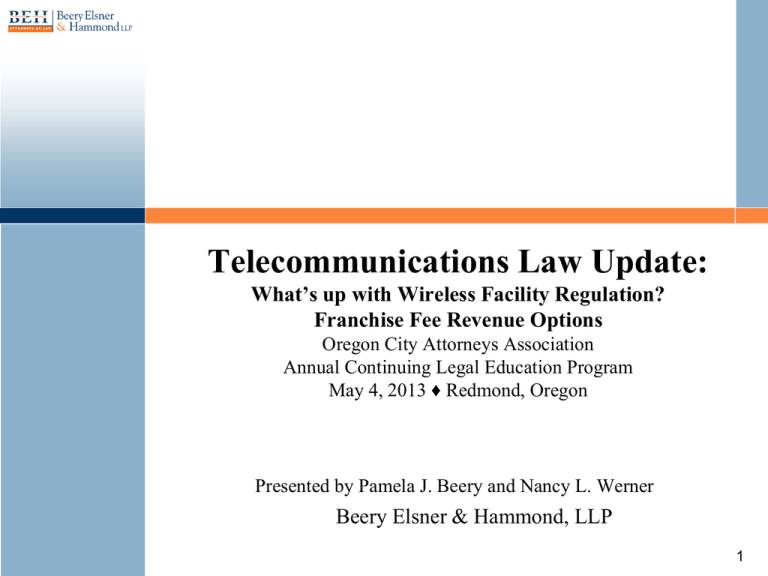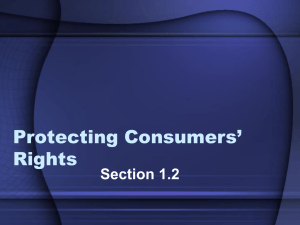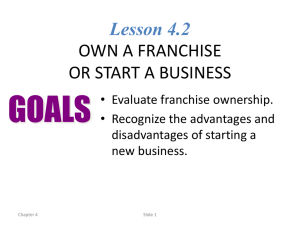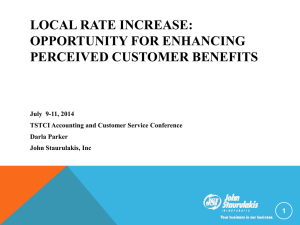Telecom Law Update - Beery Elsner & Hammond LLP
advertisement

Telecommunications Law Update: What’s up with Wireless Facility Regulation? Franchise Fee Revenue Options Oregon City Attorneys Association Annual Continuing Legal Education Program May 4, 2013 ♦ Redmond, Oregon Presented by Pamela J. Beery and Nancy L. Werner Beery Elsner & Hammond, LLP 1 Wireless Facility Siting Update It’s complicated… The Foundation: 1996 Telecom Act New FCC Regulations • The “Shot Clock Rule” (2009) – now at the US Supreme Court • Two new FCC “Notices of Inquiry” Acceleration of Broadband Deployment (WC Docket 11-59) – the “PROW NOI” Reassessment of Radio Frequency Exposure Limits (ET Docket 13-84) • FCC “Guidance” (January, 2013) • More FCC action likely…. And last but not least: 2012 Federal Collocation Statute (“Section 6409”) 2 Overview of Applicable Law TCA of 1996: 47 USC § 253 • The “no barriers to entry” law • The legal standard: local regulations cannot individually or in combination “prohibit or effectively prohibit” the provision of wireless service in the jurisdiction Applied to wireless facilities in the Ninth Circuit in Sprint Telephony PCS v. County of San Diego, 543 F.3d 571 (2008) (cert. denied) 3 Overview of applicable law (continued) TCA of 1996: 47 USC § 332(c)(7) • Preserves local zoning authority except: Local regulations may not unreasonably discriminate among providers Local regulations may not have the effect of prohibiting personal wireless service Reasonable time limitations apply to applications Written decision is required RF concerns are not a basis for denial 4 Overview of applicable law (cont’d) Leading court decisions under § 332 • MetroPCS v. San Francisco, 400 F.3d 715 (9th Cir., 2005) • T-Mobile USA, Inc. v. City of Anacortes, 572 F.3d 987 (9th Cir., 2009) • Sprint PCS v City of Palos Verdes Estates, 583 F.3d 716 (9th Cir., 2009) A note of caution: New York SMSA Limited Partnership, et al. v. Town of Clarkstown, New York, 612 F3d 97 (2010) – regulation impliedly preempted 5 New FCC Developments The 2009 “shot clock” rule requires speedy action on wireless applications • 90 days for collocation requests – defined as one that does not “substantially increase” the size of a tower • 150 days for new sites • Creates a “reasonable time” burden of proof shift to a local government as a defense in a court challenge under the rule No denial just because “one or more carriers already serve a given geographic market” FCC authority to issue the rule challenged… 6 New FCC Developments (cont’d) City of Arlington, Texas, et al. v. FCC, 668 F3d 229 (CA5, 2012) • US Supreme Court granted certiorari 10/5/12 • Oral arguments held 1/16/13 • Decision anticipated soon 7 New FCC Developments (cont’d) 2011 PROW NOI • Still pending • FCC inquiry about federal control of pricing and wireless siting practices as a means of expediting deployment • Extensive input from local government by national organizations and local communities 2013 RF NOI • Issued 3/29/13, in comment period for 150 days • Sweeping inquiry regarding FCC role in regulating RF emissions, how they are measured, regulated • Too early to say whether zoning regulations will be impacted 8 And Congress wades in… Middle Class Tax Relief and Job Creation Act of 2012…includes 47 USC § 1455(a) (2/23/12) • Mandates approval of certain applications for collocation, removal or replacement of transmission equipment • On an “existing wireless tower or base station” • Provision is often referenced as “Section 6409” 9 State legislatures follow suit… Not Oregon as of yet Map of states in handout 10 Recommendations Consider review and potential update of your zoning regulations • Make a good local record and know the boundaries • Balance increasing focus on residential communication capacity against community values • Be wary of regulating specific technologies (example: the new DAS proliferation, see New York SMSA v. Clarkstown, 612 F.3d 97 (2010) • Two recent examples: Salem and Redmond 11 Recommendations (cont’d) Consider evaluating your regulation of rights of way generally; both as to wireless and other providers Address aesthetic concerns Address compensation for use of City rights of way Provide a streamlined administrative mechanism to address applications 12 Overview of Applicable Law Home Rule – Oregon Constitution, Art. XI, Sec. 2 Start with the premise that a city with a home rule charter has authority to impose taxes and fees on telecommunications providers unless there is an applicable preemption – See Jarvill v. City of Eugene, 289 Or. 157, 168-69, 613 P.2d 1 (1980); US West Communications, Inc. v. City of Eugene, 336 Or. 181, 186 (2003) Then look for applicable preemptions 13 Overview of Applicable Law (cont’d) Potential State Law Preemptions ORS 221: • Limits privilege taxes on “telecommunications carriers” Does not apply to competitive providers • 221.450 limits the “privilege tax” on telecom carriers for use of ROW without a franchise to 5% of gross revenue • 221.515 limits the “privilege tax” on telecom carriers for use of ROW to 7% of revenue from exchange access services 14 Overview of Applicable Law (cont’d) ORS 221 (cont’d): • HB 2455 (2013): Address potential discrepancy between incumbents and competitive providers (including VoIP) due to preemption in ORS 221.515 Original bill adds competitive providers to limitation in ORS 221.515; expands revenue base to all revenue not just exchange access services, but rate is left blank. If blank is filled in, likely to be considerably less than 7% Proposed amendments to HB 2455 would repeal ORS 221.515 15 Overview of Applicable Law (cont’d) Oregon Constitution Article I, § 32 “All taxation shall be uniform on the same class of subjects within the territorial limits of the authority levying the tax” Lane County trial court in Eugene v. Comcast used this as a basis to strike down a Eugene fee based on lack of uniform application of a tax on internet access services Case is on appeal 16 Overview of Applicable Law (cont’d) Telecommunications Act of 1996 Preempts local regulations that prohibit or have the effect of prohibiting the provision of telecom services (47 U.S.C. § 253(a)) Preserves local authority to regulate the ROW, and to receive fair compensation for that use (47 U.S.C. § 253(c)) In the 9th Circuit, it is clear that franchise fees are not preempted; different fees for different providers (e.g., ILECs v. CLECs) are not preempted unless it has the effect of prohibiting service and does not fall into safe harbor of § 253(c) (See Sprint v. San Diego County, 543 F.3d 571 (9th Cir. 2008).) 17 Overview of Applicable Law (cont’d) Cable Communications Policy Act of 1984 Franchise fees on cable operators capped at 5% of gross revenue (47 U.S.C. § 542) Does not preempt exercise of home rule authority to assess a fee on other services provided by cable operators Cannot rely on Cable Act to assess non-cable fees or otherwise regulate cable operators’ telecom services through the cable franchise (47 U.S.C. § 541(b)(3)) 18 Overview of Applicable Law (cont’d) Internet Tax Freedom Act Imposes a moratorium on taxes on internet access services through 2014 (47 U.S.C. § 151 (note)) Moratorium has been extended several times; assume it will be extended again Exempts VoIP from the moratorium (47 U.S.C. § 151 (note), ITFA § 1105(5)(D)) Preempted “tax” does not include fees assessed “for a privilege or benefit conferred” and excludes “any franchise fee or similar fee imposed” pursuant to the Cable Act or Telecom Act (47 U.S.C. § 151 (note), ITFA § 1105(8)) 19 Potential Revenue Options Incumbent Providers Long-term owner of facilities; traditionally has a franchise and pays franchise fee ORS 221.515 limits franchise fees for use of ROW by incumbents to 7% of exchange access services Can capture additional revenue through a fee on the provision of service, not for use of ROW (See US West Communications, Inc. v. City of Eugene, 336 Or 181, 186 (2003).) 20 Potential Revenue Options (cont’d) Competitive Providers Facility owners should get franchise, license or other authorization to place facilities in ROW and pay associated fees • Consider per foot fee for providers that do not serve customers in city • Consider a fee of the greater of a percentage of revenue or a per foot fee • Service Providers that do not own facilities are subject to a fee for provision of service to customers ORS 221.515 does not apply But watch HB 2455 and upcoming Court of Appeals decision in Eugene v. Comcast regarding Article I § 32 21 Potential Revenue Options (cont’d) Wireless Providers No applicable preemption • Section 253 of the Telecom Act applies to wireless providers, but preemption only applies if the tax/fee is such that it has the effect of prohibiting the provision of services • Sprint v. San Diego County sets a high bar for showing an effective prohibition Challenge is political • Industry funds opposition to tax and referral efforts 22 Potential Revenue Options (cont’d) Voice over Internet Protocol Subset of competitive providers Often cable operators use cable system to provide VoIP, usually without franchise (other than the cable franchise) or paying franchise fee/privilege tax Subject to same requirements as other competitive providers Providers often cite Internet Tax Freedom Act or Cable Act as preemptions; these do not preempt Also cite lack of classification of VoIP under federal law/FCC rules; no classification = no applicable preemption • Watch HB2455 23 Potential Revenue Options (cont’d) Internet Access Services Internet Tax Freedom Act preempts taxes on services but not on use of the ROW Trial court in Eugene v. Comcast reached this conclusion; watch for the Court of Appeals decision Few Oregon cities are charging fees for ROW use by internet providers • Potential legal challenges if attempt to do so • Potential political concerns as internet access is often viewed as an important economic development tool Issue is coming up more frequently as entities install facilities exclusively for data/internet access • Phone and cable companies expect level playing field • Precedent for allowing free use of ROW for internet? 24 Recommendations Evaluate your telecom tax and fee structure Fees for both use of ROW and provision of service maximize the providers and services to which fees apply • City of Eugene has a time- and court-tested model • Consider applying the fees to all utilities, not just telecom Could capture lost revenue from owners of other facilities, such as electric service suppliers and gas providers LOC has a model ordinance to consider Keep an eye on HB 2455 and Court of Appeals 25











